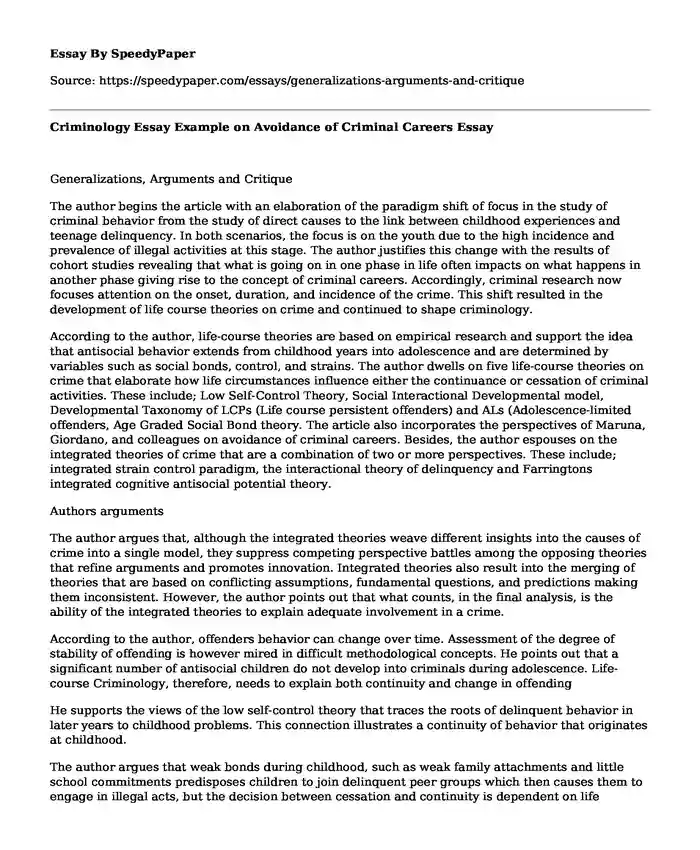
| Type of paper: | Essay |
| Categories: | Criminal law |
| Pages: | 3 |
| Wordcount: | 661 words |
Generalizations, Arguments and Critique
The author begins the article with an elaboration of the paradigm shift of focus in the study of criminal behavior from the study of direct causes to the link between childhood experiences and teenage delinquency. In both scenarios, the focus is on the youth due to the high incidence and prevalence of illegal activities at this stage. The author justifies this change with the results of cohort studies revealing that what is going on in one phase in life often impacts on what happens in another phase giving rise to the concept of criminal careers. Accordingly, criminal research now focuses attention on the onset, duration, and incidence of the crime. This shift resulted in the development of life course theories on crime and continued to shape criminology.
According to the author, life-course theories are based on empirical research and support the idea that antisocial behavior extends from childhood years into adolescence and are determined by variables such as social bonds, control, and strains. The author dwells on five life-course theories on crime that elaborate how life circumstances influence either the continuance or cessation of criminal activities. These include; Low Self-Control Theory, Social Interactional Developmental model, Developmental Taxonomy of LCPs (Life course persistent offenders) and ALs (Adolescence-limited offenders, Age Graded Social Bond theory. The article also incorporates the perspectives of Maruna, Giordano, and colleagues on avoidance of criminal careers. Besides, the author espouses on the integrated theories of crime that are a combination of two or more perspectives. These include; integrated strain control paradigm, the interactional theory of delinquency and Farringtons integrated cognitive antisocial potential theory.
Authors arguments
The author argues that, although the integrated theories weave different insights into the causes of crime into a single model, they suppress competing perspective battles among the opposing theories that refine arguments and promotes innovation. Integrated theories also result into the merging of theories that are based on conflicting assumptions, fundamental questions, and predictions making them inconsistent. However, the author points out that what counts, in the final analysis, is the ability of the integrated theories to explain adequate involvement in a crime.
According to the author, offenders behavior can change over time. Assessment of the degree of stability of offending is however mired in difficult methodological concepts. He points out that a significant number of antisocial children do not develop into criminals during adolescence. Life-course Criminology, therefore, needs to explain both continuity and change in offending
He supports the views of the low self-control theory that traces the roots of delinquent behavior in later years to childhood problems. This connection illustrates a continuity of behavior that originates at childhood.
The author argues that weak bonds during childhood, such as weak family attachments and little school commitments predisposes children to join delinquent peer groups which then causes them to engage in illegal acts, but the decision between cessation and continuity is dependent on life commitments such as marriage and employment
Critique
Moffitt's theory of Developmental Taxonomy of LCPs and ALs classifies offenders into only two groups, the LCPs, and the LCs. These groupings cannot adequately account for the complexity of development into and out of crime. Additionally, the study of types of offenders is such a cumbersome task due to the complexities of social behavior.
Elliotts et al. integrated strain control paradigm theory suggests that the social learning variables would only take effect in adolescence and only through deliquescent peer groups. However, studies show that peer groups start to exert influence during childhood. Besides there are some channels through which teenagers begin criminal activities. The view of the family as a socializing agent that inculcates bonds as opposed to an environment in which social learning occurs is also subject to debate.
Question to be posted on the Discussion Board for response by other students.
Could some of the offenders actions be as a result of inherited traits that resurface in the adult years despite controls at an early age?
Cite this page
Criminology Essay Example on Avoidance of Criminal Careers. (2019, Jun 25). Retrieved from https://speedypaper.net/essays/generalizations-arguments-and-critique
Request Removal
If you are the original author of this essay and no longer wish to have it published on the SpeedyPaper website, please click below to request its removal:
- Psychology Essay Example: Salma's Personality
- Art Essay Example: Glass and Fruit by George Braque
- Strategic Management Essay Example on the Car Toys Company
- Essay Sample: Marriage Analysis in Romeo and Juliet and Much Ado about Nothing
- Tobacco Talk Essay Sample
- Essay Example on How to Market Yourself on the Job Market
- Essay Sample on Root Causes of Low Crimes Resulting in Capital Punishments
Popular categories




